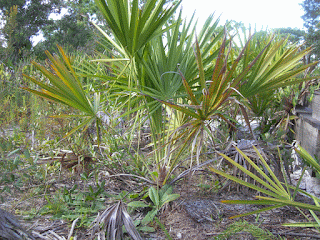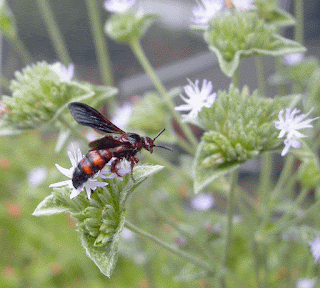Just before the "stay home" order I got to visit the
All Native Plant Nursery in Fort Myers with one of my sisters. What a treat! It had been far too long since my last visit. I bought too many plants - our yard is already crowded. My reason for going was the need for a Bahama Cassia, but of course, I bought more than that one plant. (For some reason I can't link back to my own blog, but in "The Butterfly Effect," posted on 1/23/20, I talk about Bahama Cassia).
A wonderful mix of "minty" fresh foliage and the heady fragrance of several varieties of viburnums enveloped us as soon as we entered the sales area. I really wanted one, not only for the fragrance, but also for birds, but it is too unruly for our small yard.
I planted one once, and after a few years had to dig it out - not an easy job. It had suckered exuberantly, and was showing no sign of slowing down. Still, if any space should open up, I will definitely consider some of the newer, more compact varieties of this multi-purpose shrub.
We didn't look at the big trees. That would have been fun, but we didn't have time, and while we could use the shade in our yard, again, there's no room for a live oak or a majestic gumbo-limbo.
Apart from the delight of so many flourishing native plants, just strolling the shaded pathways was a pleasure. I would love to return with my sketchbook and just draw for a few hours.
 |
Shady paths and an abundance of plants - A gardener's dream
Sunshine Mimosa in foreground |
Against better judgment, I bought a beach morning glory,
Ipomoea imperatii. This morning glory doesn't climb, and in our loose, sandy "soil" expands its territory quickly. I hope I can keep this one in check in a large pot. I'll let it sprawl down the sides some, and with any luck I'll keep it tidy. The dark green foliage and the white flower, with just the slightest hint of yellow-green, are very attractive.
I had one some years ago, and it not only overran our yard, but was in the process of marching through the one next door. There was nobody living there at the time, so I didn't have to fess up to my sins or explain what I was doing with trowel and hand rake on somebody else's property. I overdid the cleanup, though, because it vanished from our yard as well.
 |
| Ipomoea imperatii - Beach Morning Glory |
The basal rosettes of starry rosinweed,
Silphium astericus were incredibly vigorous. It wasn't the promise of bright yellow flower heads, but the fantastic raspy leaves that made this plant irresistible. I can't wait to try to draw it. I planted it in an area that gets strong sun, but also some shade. It's doing well, and growing upwards.
 |
Starry Rosinweed - Silphium astericus
|
A lovely trellised
Pentalinon luteum, wild allamanda, or hammock viper's tail, was another "must-have" once I had seen it. There is one in our yard, but it suffered with Hurricane Irma in 2017, and had been looking puny. I wasn't even sure if it would survive another year. Sure enough, as soon as I planted the "replacement" nearby, the old plant put out a burst of new growth. That's great. As far as I'm concerned, you can't have too much of this gorgeous flowering vine. The large, tubular flowers are a glowing lemon-yellow. They last only one day, but there's always another bud getting ready to bloom.
 |
| Pentalinon luteum in Full Bloom |
Pentalinon blooms profusely, and over a fairly long period. Its shiny bright yellow-green leaves make it attractive even when it is not flowering. (If I don't irrigate it during our dry and windy winters and early spring, it may lose some or most leaves and go into a brief period of semi-dormancy). Now and again various species of oleander moth chew on it, and they have the irritating habit of going after the flowers before tackling the leaves. Unless the infestation is particularly serious, I usually let it run its course, because the day-flying oleander moths are beautiful too.
 |
| Pentalinon luteum, Flower and Buds |
We almost overlooked the bird peppers (
Capsicum annuum var.
glabriusculum) sitting on a bench in partial shade. Bird pepper is the ancestor of all our hot peppers. In the U.S. it occurs naturally in Texas, Arizona and Florida. It also grows in the Bahamas, the Caribbean, and parts of Mexico, Central America and Columbia.
You've got to pick the fruits fast, because the birds, especially mockingbirds, gobble them. The peppers have a nice burn that is great for imparting extra flavor to what you are cooking. It's another plant I killed by neglecting it totally. I'm still looking for just the right place for it. There are plenty of spaces where I could tuck it away, but I want it close enough to the patio so that it's easy to tend, and also so we can watch the birds. I may decide on puttiing it in a large pot for now.
Last, but not least, sea lavender,
Argusia gnaphalodes, a member of the Borage Family. Decades ago I saw it in Aruba and fell in love with it. I had never seen it on a Florida beach. The linear leaves are a pale, felty gray. It is a resident of sand dunes, and an important beach stabilizer. It is endangered now because so much beach habitat has been developed.
It's not frequently available, due to the difficulty of propagating it. I placed it in a barren spot near the seawall, where the soil is scarcely rich, and where the drainage is almost too good. The site is in easy reach of the garden hose, though, so I am pampering it with plenty of water until until it has established itself. Then it should be pretty much a "cast-iron" plant that will thrive on neglect.
I also bought a book,
A Land Remembered, by Patrick D. Smith, that chronicles 3 generations of a "cracker" family coping with the Florida wilderness, and the changes brought by increasing settlement. That's a pretty impressive haul, but there were so many more things, especially wildflowers, that I wanted to try, or even multiples of the same plant.
Having a good native plant nursery within reach is a real luxury. When I first moved to this area in 1993, native plants generally were available only once a year at the plant sales hosted by local chapters of the Florida Native Plant Society. Most of the plants had to be brought in from Florida's east coast. We owe the founder and owner of All Native Garden Center, John Sibley, who is a stalwart supporter of the Florida Native Plant Society both statewide and locally, a huge thanks.
And now that I have a selection of beautiful new plants, I need to get back to my sketchbook!
 |
| Pentalinon luteum |
















































